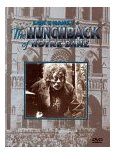FILM NOTES
FILM NOTES INDEX
NYS WRITERS INSTITUTE
HOME PAGE

 The Hunchback of Notre Dame
The Hunchback of Notre Dame
(United States, 1923, 120 minutes, b&w, 16mm)
Directed by Wallace Worsley
Cast:
Lon Chaney . . . . . . . . . . Quasimodo
Patsy Ruth Miller . . . . . . . . . . Esmeralda
Norman Kerry . . . . . . . . . .Phoebus de Chateaupers
Kate Lester . . . . . . . . . . Madame de Condelaurier
The
following film notes were prepared for the New York State Writers
Institute by Kevin Jack Hagopian, Senior Lecturer in Media Studies
at Pennsylvania State University:
He was born in 1883, the child of deaf-mute parents, and by the end of his life in 1930, he had become the most articulate star of a silent medium. He was Lon Chaney, and in The Hunchback of Notre Dame, he achieved one of the many pinnacles of his prolific (over 150 films). His studio promoted him as "The Man of a Thousand Faces" for his astonishing retinue of costume-and-makeup characters, each of them self-designed. But perhaps a more accurate monicker would be "The Man of a Hundred Moods," for, in each of his films, Chaney offered characters who were both demonic and pathetic, both selfish and compassionate, both brutal and gentle; in short, characters who were as paradoxical as real people. Chaney’s films were called "horror films" because of his eccentric and frightening make-up, but what was horrific in them were the things that are horrific in all people, presented in monstrous measure: the strange compulsions, secret sorrows, and self-destructive vendettas that too often give perverse meaning to our lives. The physical disabilities Chaney gave his characters in films like The Unknown, Shadows, West of Zanzibar, The Penalty, and The Phantom of the Opera were the expressions of those benighted souls’ inner torment.
Out of Chaney’s makeup kit came an endless variety of stories, but Chaney made his characters out of far more than grease paint, false hair, and dental appliances. It was said that he had "a deaf face"; he had learned to communicate with his parents through his expressions, as well as sign language. (Indeed, when his mother was dying, she had lost the use of her arms, so mother and son "talked" solely by facial expression.) No actor has ever expressed more with vast, soul-filled eyes and soundless mouth than Lon Chaney.
The Hunchback of Notre Dame was not the first time Chaney had played a character afflicted with this condition of the spine. In 1914’s Alas and Alack, Chaney played two brothers, one hunchbacked, and one not. But The Hunchback of Notre Dame was perhaps the most ambitious project in the history of Universal studios; on it depended the studio’s very future. The massive cathedral set, even though partly realized through a special effects perspective technique called a "glass shot," was one of the largest sets built to that time. Chaney quite literally carried the entire film on his deformed back; as the crippled bellringer Quasimodo, his foredoomed love for the gypsy girl Esmeralda, his incredible acrobatics, and the visible anguish his character suffered -- the whipping scene is surely among the most heartbreaking examples of human misery in all of cinema -- would cement Universal’s position as `the house of horror’ through the 1940’s.
Quasimodo terrified everyone, but children who saw the film, in particular, never forgot it. The brilliant writer of the supernatural, Ray Bradbury, addicted to the movies as a boy in Waukegan, Illinois, was one of those wide-eyed kids. Chaney, said Bradbury, was "Someone who acted out our psyche. He somehow got into the shadows inside our bodies. He was able to nail down our secret fears, and put them on the screen."
As a boy, an impressionable Orson Welles saw Chaney's films, and was enraptured by the combination of grotesquery and empathy Chaney brought up from the dark places in the human soul. As a child, Welles was thrown out of the Washington School in Madison, Wisconsin, for wearing a Halloween costume so disturbing that his teacher ran screaming from the room; he must surely have been imitating Chaney. Chaney, said Welles in an interview many years later, was "an actor of great power and enormous eloquence." Welles developed a lifelong fascination for characters built out of make-up and costume, and Lon Chaney’s spirit could be seen in Welles’ own great, larger than life, heavily made-up character, Charles Foster Kane.
After The Hunchback of Notre Dame’s success, Chaney was one of Hollywood’s most popular stars. When he signed with fledgling MGM, he joined John Gilbert and Greta Garbo as the young studio’s biggest attractions. By the end of the decade, Chaney’s name had become synonymous with horror. He even rated a novelty number in the musical Hollywood Revue of 1929 called "Lon Chaney's Gonna Get You If you Don't Watch Out." Chaney, whose voice in talking pictures proved as unique as his face, was being discussed for the leads in the new wave of horror films which sound would bring to the American screen, films such as Frankenstein and Dracula. Tragically, he was diagnosed with bronchial cancer, and he died as one of his own characters might have – mute and triumphant.
— Kevin Hagopian, Penn State University
For additional information, contact the Writers Institute at 518-442-5620 or online at https://www.albany.edu/writers-inst.